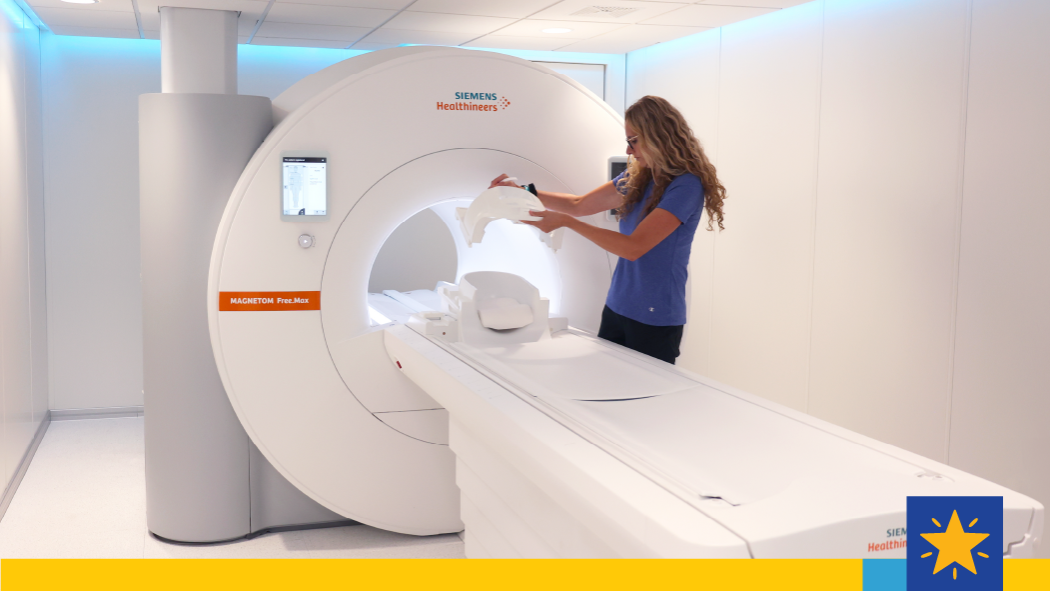
July 25, 2024
With a lower strength magnet, artificial intelligence (AI) capabilities, a larger opening for patients, and a dedicated focus on serving non-urgent/non-emergent cases, London Health Sciences Centre’s (LHSC’s) new MAGNETOM Free.Max MRI machine will help reduce wait times for patients while promoting inclusive care.
Patients will begin to be scanned with this new machine at LHSC beginning in early August. A first of its kind in Ontario, the Siemens MAGNETOM Free.Max 0.55T MRI is in a self-contained unit that is located outside of Victoria Hospital and connected by an enclosed walkway. The machine arrived on a flatbed, was lifted into place using a crane and did not require the usual construction and costs associated with creating space for an MRI.
“This particular MRI machine provides high performance using a lower-strength magnet with the latest AI technology to provide fast, high-quality images of areas like the brain, the spine and the knee comparable to a regular MRI,” explains Dr. Narinder Paul, Department Head, Medical Imaging. “This is the right level of scanning needed for this patient population.”
The new 0.55T MRI machine increases LHSC’s capacity to see more patients more efficiently and is anticipated to significantly reduce wait times.
As a newer technology that requires less construction and operating costs due to a smaller magnet, there is opportunity for the scanner to have a system-wide impact.
“It's a really exciting opportunity as LHSC will be one of the first hospitals in Canada and the first in Ontario to have this technology,” said John French, Clinical Diagnostics Executive. “We will be able to evaluate how this technology can reduce wait times and improve access to care.”
This latest MRI also allows care teams to operate the machine from a distance. LHSC will be examining the potential of this feature in the future. An example of this would be having a technologist at one location, such as University Hospital, operate the device located at Victoria Hospital.
Michelle Cress has been a medical radiation technologist working with MRIs for 12 years. Cress is one of the technologists who will be using the new scanner and is excited about the positive impact the machine will have on patients, staff and wait times.
“It's very exciting because it has a lot of features including the first 80-centimetre-wide opening in Canada, roughly 15 per cent larger than a standard MRI machine, which means patients will be more at ease,” says Cress. “It will definitely help with improving comfort for our claustrophobic and larger build patients, and may result in fewer sedation cases.”
“This investment highlights our commitment to addressing challenges like MRI wait times through innovation,” said David Musyj, Interim President and CEO. "We are grateful to Ontario Health and the Ministry of Health for helping us to fund this new MRI technology, which raises the standard of diagnostic imaging and reflects our dedication to making advanced health care accessible.”
Patients will begin to be scanned with the new MAGENTOM Free.Max MRI located at Victoria Hospital beginning in early August. The MRI will initially be in use from Monday to Friday from 8:00 a.m. to 4:00 p.m.
Research using the Free.Max MRI
The new MAGNETOM Free.Max 0.55T MRI will provide new research opportunities to Team LHSC. There are eight research projects currently planned with the MRI, all led by technologists looking at different aspects of this machine, including scanning of the head, musculoskeletal system, and the heart, as well as health system research such as the ability of this technology to help increase access to currently under-served populations.
“You achieve excellent clinical care by continually innovating,” said Dr. Narinder Paul, Department Head, Medical Imaging. “Our job is to ask questions like can we do something safer? Can we do it faster? Can we improve the patient experience?”
For Dr. Paul, it is a cycle. “The innovation process is really important, and the research is really important. Innovation is part of research and research is part of clinical care.” Some of the questions that are being discussed for research on the new machine include:
- Can we reduce the amount of sedation being used for paediatric patients?
- Can we use AI technology to support the training of new technologists?
- Will the smaller magnet allow patients with metallic implants (such as pacemakers) to be eligible for scans?
- Can we use the technology to remotely scan patients?
“It’s important to look at the results and ask, have we improved patient care?” says Dr. Paul. “We’re trying to make today better than yesterday, and tomorrow better than today.”
